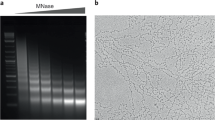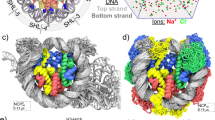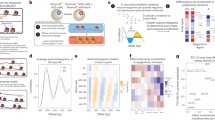Abstract
The packaging of eukaryotic DNA into chromatin sterically occludes polymerases, recombinases and repair enzymes. How chromatin structure changes to allow their actions is unknown. We constructed defined fluorescently labeled trinucleosome arrays, allowing analysis of chromatin conformational dynamics via fluorescence resonance energy transfer (FRET). The arrays undergo reversible Mg2+-dependent folding similar to that of longer arrays studied previously. We define two intermediate conformational states in the reversible folding of the nucleosome arrays and characterize the microscopic rate constants. Nucleosome arrays are highly dynamic even when compact, undergoing conformational fluctuations on timescales in the second to microsecond range. Compact states of the arrays allow binding to DNA within the central nucleosome via site exposure. Protein binding can also drive decompaction of the arrays. Thus, our results reveal multiple modes by which spontaneous chromatin fiber dynamics allow for the invasion and action of DNA-processing protein complexes.
This is a preview of subscription content, access via your institution
Access options
Subscribe to this journal
Receive 12 print issues and online access
$189.00 per year
only $15.75 per issue
Buy this article
- Purchase on Springer Link
- Instant access to full article PDF
Prices may be subject to local taxes which are calculated during checkout





Similar content being viewed by others
References
Richmond, T.J. & Davey, C. The structure of DNA in the nucleosome core. Nature 423, 145–150 (2003).
Robinson, P.J. & Rhodes, D. Structure of the '30 nm' chromatin fibre: a key role for the linker histone. Curr. Opin. Struct. Biol. 16, 336–343 (2006).
Grewal, S.I. & Elgin, S.C. Transcription and RNA interference in the formation of heterochromatin. Nature 447, 399–406 (2007).
Bühler, M. & Moazed, D. Transcription and RNAi in heterochromatic gene silencing. Nat. Struct. Mol. Biol. 14, 1041–1048 (2007).
Fousteri, M., van Hoffen, A., Vargova, H. & Mullenders, L.H. Repair of DNA lesions in chromosomal DNA impact of chromatin structure and Cockayne syndrome proteins. DNA Repair (Amst.) 4, 919–925 (2005).
Topp, C.N. & Dawe, R.K. Reinterpreting pericentromeric heterochromatin. Curr. Opin. Plant Biol. 9, 647–653 (2006).
Brutlag, D.L. Molecular arrangement and evolution of heterochromatic DNA. Annu. Rev. Genet. 14, 121–144 (1980).
Chen, L. & Widom, J. Mechanism of transcriptional silencing in yeast. Cell 120, 37–48 (2005).
Chen, D. et al. Condensed mitotic chromatin is accessible to transcription factors and chromatin structural proteins. J. Cell Biol. 168, 41–54 (2005).
Cheutin, T. et al. Maintenance of stable heterochromatin domains by dynamic HP1 binding. Science 299, 721–725 (2003).
Polach, K.J. & Widom, J. Mechanism of protein access to specific DNA sequences in chromatin: a dynamic equilibrium model for gene regulation. J. Mol. Biol. 254, 130–149 (1995).
Li, G. & Widom, J. Nucleosomes facilitate their own invasion. Nat. Struct. Mol. Biol. 11, 763–769 (2004).
Li, G., Levitus, M., Bustamante, C. & Widom, J. Rapid spontaneous accessibility of nucleosomal DNA. Nat. Struct. Mol. Biol. 12, 46–53 (2005).
Bucceri, A., Kapitza, K. & Thoma, F. Rapid accessibility of nucleosomal DNA in yeast on a second time scale. EMBO J. 25, 3123–3132 (2006).
Bernstein, B.E., Liu, C., Humphrey, E.L., Perlstein, E.O. & Schreiber, S. Global nucleosome occupancy in yeast. Genome Biol. 5, R62 (2004).
Tirosh, I. & Barkai, N. Two strategies for gene regulation by promoter nucleosomes. Genome Res. 18, 1084–1091 (2008).
Adams, C.C. & Workman, J.L. Binding of disparate transcriptional activators to nucleosomal DNA is inherently cooperative. Mol. Cell. Biol. 15, 1405–1421 (1995).
Polach, K.J. & Widom, J. A model for the cooperative binding of eukaryotic regulatory proteins to nucleosomal target sites. J. Mol. Biol. 258, 800–812 (1996).
Miller, J.A. & Widom, J. Collaborative competition mechanism for gene activation in vivo. Mol. Cell. Biol. 23, 1623–1632 (2003).
Vashee, S., Willie, J. & Kodadek, T. Synergistic activation of transcription by physiologically unrelated transcription factors through cooperative DNA-binding. Biochem. Biophys. Res. Commun. 247, 530–535 (1998).
Luger, K. & Hansen, J.C. Nucleosome and chromatin fiber dynamics. Curr. Opin. Struct. Biol. 15, 188–196 (2005).
Widom, J. Toward a unified model of chromatin folding. Annu. Rev. Biophys. Biophys. Chem. 18, 365–395 (1989).
Poirier, M.G., Bussiek, M., Langowski, J. & Widom, J. Spontaneous access to DNA target sites in folded chromatin fibers. J. Mol. Biol. 379, 772–786 (2008).
Clegg, R.M. Fluorescence resonance energy transfer and nucleic acids. Methods Enzymol. 211, 353–388 (1992).
Lowary, P.T. & Widom, J. New DNA sequence rules for high affinity binding to histone octamer and sequence-directed nucleosome positioning. J. Mol. Biol. 276, 19–42 (1998).
Schalch, T., Duda, S., Sargent, D. & Richmond, T. X-ray structure of a tetranucleosome and its implications for the chromatin fibre. Nature 436, 138–141 (2005).
Dorigo, B. et al. Nucleosome arrays reveal the two-start organization of the chromatin fiber. Science 306, 1571–1573 (2004).
Routh, A., Sandin, S. & Rhodes, D. Nucleosome repeat length and linker histone stoichiometry determine chromatin fiber structure. Proc. Natl. Acad. Sci. USA 105, 8872–8877 (2008).
Dorigo, B., Schalch, T., Bystricky, K. & Richmond, T. Chromatin fiber folding: requirement for the histone H4 N-terminal tail. J. Mol. Biol. 327, 85–96 (2003).
Bussiek, M., Tóth, K., Schwarz, N. & Langowski, J. Trinucleosome compaction studied by fluorescence energy transfer and scanning force microscopy. Biochemistry 45, 10838–10846 (2006).
Du, Q., Smith, C., Shiffeldrim, N., Vologodskaia, M. & Vologodskii, A. Cyclization of short DNA fragments and bending fluctuations of the double helix. Proc. Natl. Acad. Sci. USA 102, 5397–5402 (2005).
Iqbal, A. et al. Orientation dependence in fluorescent energy transfer between Cy3 and Cy5 terminally attached to double-stranded nucleic acids. Proc. Natl. Acad. Sci. USA 105, 11176–11181 (2008).
Bao, Y., White, C.L. & Luger, K. Nucleosome core particles containing a poly(dA.dT) sequence element exhibit a locally distorted DNA structure. J. Mol. Biol. 361, 617–624 (2006).
Yao, J., Lowary, P.T. & Widom, J. Direct detection of linker DNA bending in defined-length oligomers of chromatin. Proc. Natl. Acad. Sci. USA 87, 7603–7607 (1990).
Robinson, P.J., Fairall, L., Huynh, V.A. & Rhodes, D. EM measurements define the dimensions of the “30-nm” chromatin fiber: evidence for a compact, interdigitated structure. Proc. Natl. Acad. Sci. USA 103, 6506–6511 (2006).
Shogren-Knaak, M. et al. Histone H4–K16 acetylation controls chromatin structure and protein interactions. Science 311, 844–847 (2006).
Widom, J. Chromatin structure: linking structure to function with histone H1. Curr. Biol. 8, R788–R791 (1998).
Ushinsky, S.C. et al. Histone H1 in Saccharomyces cerevisiae. Yeast 13, 151–161 (1997).
Bates, D.L. & Thomas, J.O. Histones H1 and H5: one or two molecules per nucleosome? Nucleic Acids Res. 9, 5883–5894 (1981).
Fan, Y. et al. Histone H1 depletion in mammals alters global chromatin structure but causes specific changes in gene regulation. Cell 123, 1199–1212 (2005).
Anderson, J.D., Thåström, A. & Widom, J. Spontaneous access of proteins to buried nucleosomal DNA target sites occurs via a mechanism that is distinct from nucleosome translocation. Mol. Cell. Biol. 22, 7147–7157 (2002).
Anderson, J.D. & Widom, J. Sequence and position-dependence of the equilibrium accessibility of nucleosomal DNA target sites. J. Mol. Biol. 296, 979–987 (2000).
Polach, K.J. & Widom, J. Restriction enzymes as probes of nucleosome stability and dynamics. Methods Enzymol. 304, 278–298 (1999).
Thåström, A., Bingham, L.M. & Widom, J. Nucleosomal locations of dominant DNA sequence motifs for histone-DNA interactions and nucleosome positioning. J. Mol. Biol. 338, 695–709 (2004).
Feng, H.P., Scherl, D.S. & Widom, J. Lifetime of the histone octamer studied by continuous-flow quasielastic light scattering: test of a model for nucleosome transcription. Biochemistry 32, 7824–7831 (1993).
Little, J.W. et al. Cleavage of LexA repressor. Methods Enzymol. 244, 266–284 (1994).
Thåström, A., Lowary, P.T. & Widom, J. Measurement of histone-DNA interaction free energy in nucleosomes. Methods 33, 33–44 (2004).
Bonnet, G., Krichevsky, O. & Libchaber, A. Kinetics of conformational fluctuations in DNA hairpin-loops. Proc. Natl. Acad. Sci. USA 95, 8602–8606 (1998).
Krichevsky, O. & Bonnet, G. Fluorescence correlation spectroscopy: the technique and its applications. Reports on Progress in Physics (2002).
Hess, S.T., Huang, S., Heikal, A.A. & Webb, W. Biological and chemical applications of fluorescence correlation spectroscopy: a review. Biochemistry 41, 697–705 (2002).
Elson, E.L. & Webb, W.W. Concentration correlation spectroscopy: a new biophysical probe based on occupation number fluctuations. Annu. Rev. Biophys. Bioeng. 4, 311–334 (1975).
Acknowledgements
We thank E. Elson (Washington University) and E. Matayoshi (Abbott Laboratories) for access to Zeiss Confocor 2 instruments, on which preliminary FCS experiments were carried out. We thank J. Little (University of Arizona) for the LexA expression plasmid. We thank E. Elson and E. Matayoshi and members of the Widom laboratory for discussions, K. Swinger (Northwestern University) for help with the trinucleosome structure figures and the Keck Biophysics and Biological Imaging Facilities at Northwestern University for the use of instruments. M.G.P. acknowledges support from US National Institutes of Health postdoctoral fellowship F32 GM072306 and a Career Award in the Biomedical Sciences from the Burroughs-Wellcome Fund. J.W. acknowledges research support from US National Institutes of Health grants R01 GM54692 and R01 GM58617.
Author information
Authors and Affiliations
Contributions
M.G.P. designed, executed and interpreted experiments and wrote some of the paper; E.O. designed, executed and interpreted experiments; H.S.T. designed, executed and interpreted experiments; J.W. designed and interpreted experiments and wrote some of the paper.
Corresponding authors
Supplementary information
Supplementary Text and Figures
Supplementary Figures 1–3, Supplementary Methods and Supplementary Discussion (PDF 2012 kb)
Rights and permissions
About this article
Cite this article
Poirier, M., Oh, E., Tims, H. et al. Dynamics and function of compact nucleosome arrays. Nat Struct Mol Biol 16, 938–944 (2009). https://doi.org/10.1038/nsmb.1650
Received:
Accepted:
Published:
Issue Date:
DOI: https://doi.org/10.1038/nsmb.1650
This article is cited by
-
Modulating chromatin accessibility by transactivation and targeting proximal dsgRNAs enhances Cas9 editing efficiency in vivo
Genome Biology (2019)
-
Nucleosome structure and dynamics are coming of age
Nature Structural & Molecular Biology (2019)
-
Acetylation of the histone H3 tail domain regulates base excision repair on higher-order chromatin structures
Scientific Reports (2019)
-
Jörg Langowski: his scientific legacy and the future it promises
BMC Biophysics (2018)
-
High precision FRET studies reveal reversible transitions in nucleosomes between microseconds and minutes
Nature Communications (2018)



